Winter Lawn Care in Ballarat
What You Should (and Shouldn't) Do This Season
6/30/20257 min read

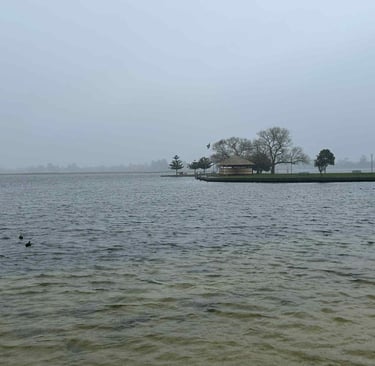
Winter in Ballarat doesn't mean your lawn care responsibilities disappear – but it does mean they change dramatically. Many homeowners make the mistake of either completely neglecting their yards or continuing summer routines that can actually damage winter grass.
At Local Yard Master, we've seen both extremes during our 4 years serving Ballarat and surrounding areas. The truth is, winter lawn care is about strategic maintenance and smart planning, not intensive treatments. Here's what Ballarat homeowners need to know about caring for their yards during the colder months.
Understanding Winter Grass Behaviour in Ballarat
Ballarat's winter climate creates unique conditions for lawn care:
Grass growth slows significantly but doesn't stop completely
Soil stays moist longer, creating different challenges than summer
Frost can damage grass if not managed properly
Reduced sunlight affects grass health and recovery
Your lawn isn't dead during winter – it's conserving energy for spring growth. Understanding this helps you make better care decisions.
What You SHOULD Do During Ballarat's Winter
1. Reduce (Don't Stop) Mowing - Cool Season Grasses ONLY
Mow less frequently – every 3-4 weeks instead of weekly
Keep grass slightly longer (about 4-5cm) for frost protection
Only mow when grass is dry to avoid soil compaction
Ensure mower blades are sharp to prevent tearing
2. Manage Foot Traffic
Winter grass is more vulnerable to damage. Create designated pathways and avoid walking on frosty grass, which can cause permanent brown patches.
3. Clear Debris Regularly
Remove fallen leaves that block sunlight
Clear branches and other debris after storms
Keep gutters clean to prevent overflow onto lawn areas
4. Plan Your Spring Strategy Winter is perfect for:
Assessing what worked and didn't work last year
Planning landscape improvements
Booking spring services early (we recommend August bookings)
Budgeting for annual lawn care programs
What You Should NOT Do This Winter
Mistake 1: Mowing Dormant Grass Mowing dormant grass is generally not recommended, as it can damage the grass and potentially hinder its recovery in the spring. Dormant grass is resting and conserving energy, and cutting it can stress the plants and weaken their root systems.
Mistake 2: Fertilizing Too Early Many Ballarat homeowners think winter fertilizing gives them a head start. Actually, it encourages growth when grass should be conserving energy, making it more susceptible to frost damage.
Mistake 3: Overwatering Winter soil retains moisture longer. Overwatering creates fungal problems and root rot. Let natural rainfall handle most watering needs.
Mistake 4: Ignoring Drainage Issues Winter's the perfect time to notice where water pools on your property. These areas will cause problems all year if not addressed.
Mistake 5: Cutting Grass Too Short Short grass has less protection against frost. Keep it longer during winter months.
Understanding Your Grass Type This Winter
If you're wondering why your lawn looks less vibrant right now, it's likely because you have warm-season grass varieties that naturally go dormant during Ballarat's winter months. The two most common types in our area – kikuyu grass and buffalo grass – behave quite differently from cool-season varieties during winter.
Kikuyu Grass in Winter: Kikuyu grass enters dormancy when soil temperatures drop below 10°C, which typically happens in late May around Ballarat. During dormancy, kikuyu grass stops growing and often turns brown or yellow – this is completely normal and not a sign of death. The grass is conserving energy in its root system and will bounce back vigorously in spring. Don't panic if your kikuyu lawn looks patchy or discolored right now; it's just sleeping.
Buffalo Grass Winter Behavior: Buffalo grass varieties (like Sir Walter, Sapphire, and Shademaster) are slightly more cold-tolerant than couch but still slow dramatically in winter. Buffalo tends to maintain more green color than couch during dormancy but grows very slowly. You'll notice thicker buffalo varieties like Sir Walter may look dense but require much less frequent mowing – sometimes only once a month during peak winter.
What This Means for Your Winter Care: Both grass types need minimal intervention during dormancy. Avoid fertilizing, reduce watering, and mow less frequently. The key is patience – your lawn isn't dying, it's just waiting for warmer weather to return. Come September, both couch and buffalo will green up and start growing actively again, ready for your spring lawn care program.
Understanding your grass type helps you avoid common winter mistakes like over-fertilizing dormant lawns or panicking about natural color changes.
The Cool-Season Grasses of Ballarat
Cool-Season Grasses Thrive in Winter
While warm-season varieties like couch and buffalo go dormant, cool-season grasses actually perform their best during Ballarat's winter months. If you have ryegrass, tall fescue, or fine fescue in your lawn, you're in luck – these grasses love the cooler temperatures and increased moisture that winter brings.
Active Growth During Cold Months: Cool-season grasses continue growing when soil temperatures are between 10-18°C, which covers most of Ballarat's winter period. Unlike their warm-season cousins, these grasses maintain their green color and may even grow more vigorously during mild winter days. You'll notice ryegrass stays lush and green, while fescue varieties develop their characteristic thick, hardy appearance.
Winter Care for Cool-Season Varieties: These grasses require different winter management than dormant warm-season types. Continue regular mowing (though less frequently), maintain consistent moisture levels, and consider light fertilizing in late winter to support their active growth. Cool-season grasses are also more tolerant of foot traffic during winter months, making them ideal for high-use areas.
The Trade-Off: While cool-season grasses excel in winter, they struggle during Ballarat's hot summers and may require more water and care during peak heat. This is why many local properties have mixed grass types – warm-season for summer resilience and cool-season patches for winter performance.
Understanding which grass types you have helps you tailor your winter care approach and explains why some areas of your lawn might be thriving while others appear dormant.
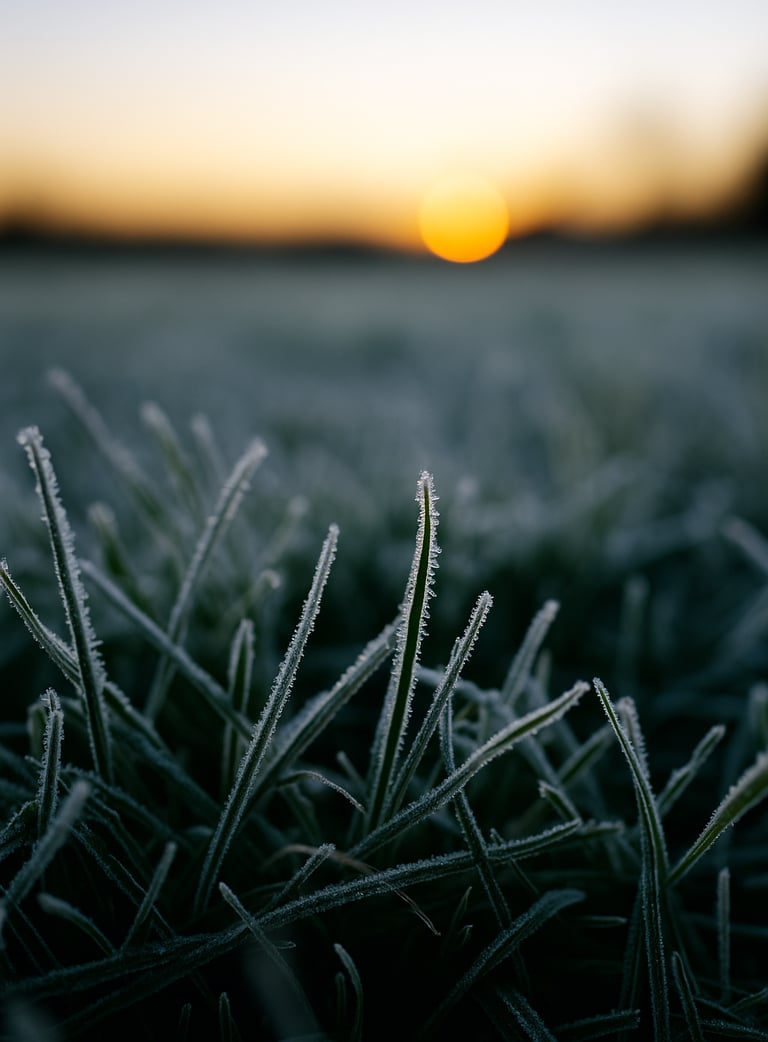

Winter Grass Dormancy: Buffalo & Kikuyu in Ballarat
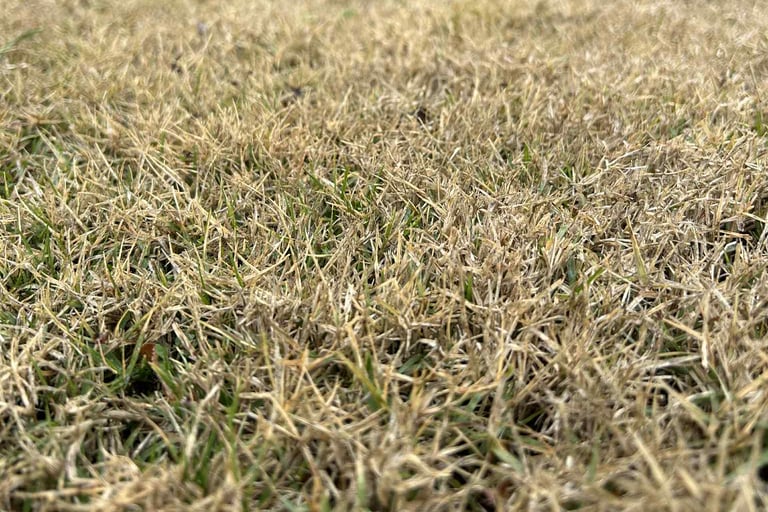

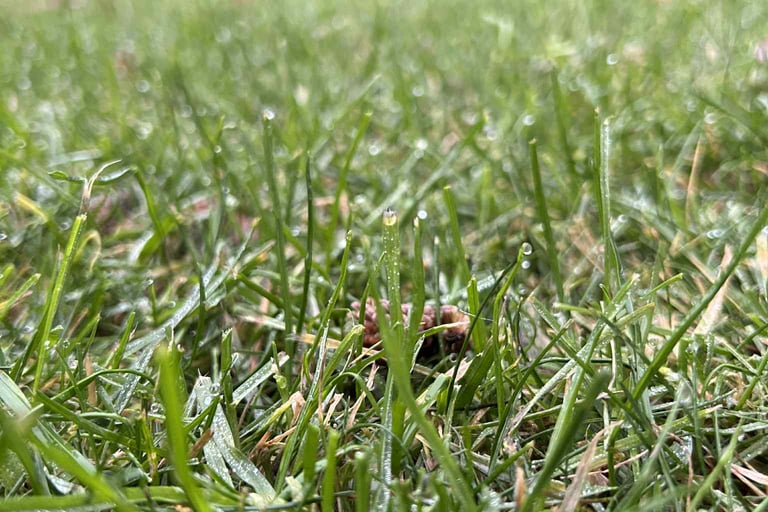

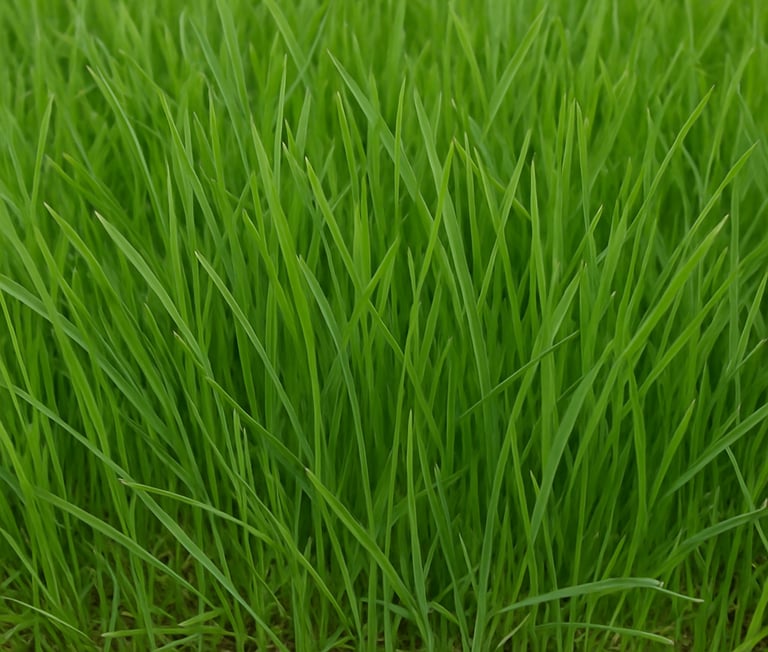





3 Most Common Grasses In Ballarat
Tall Fescue
Cool Season Grass
Kikuyu
Warm Season Grass
Warm Season Grass
Buffalo
Common Winter Lawn Care Questions & Solutions for Ballarat Homeowners
Here are the most frequent questions we get from Ballarat customers during winter months, along with practical solutions:
"My lawn looks dead – is it actually dying?"
Answer: Most likely, your warm-season grass (couch or buffalo) is just dormant, not dead. Perform the "tug test" – gently pull on brown grass. If it comes out easily with no resistance, it may be dead. If there's resistance and you can see white/green at the base, it's dormant and will recover in spring. Cool-season grasses should stay green, so browning in ryegrass or fescue needs investigation.
"Should I keep watering in winter?"
Answer: Reduce watering significantly but don't stop completely. Water deeply once every 2-3 weeks if there's no natural rainfall. Dormant warm-season grasses need minimal water, while active cool-season varieties need consistent moisture. Check soil 5cm down – if it's moist, skip watering.
"When should I stop mowing completely?"
Answer: Never stop completely, but reduce frequency dramatically. Dormant grasses: mow monthly or when growth reaches 6-7cm. Active cool-season grasses: mow every 2-3 weeks. Always mow when grass is dry to prevent soil compaction and disease.
"My neighbor's lawn is green, mine is brown – what's wrong?"
Answer: You likely have different grass types. Cool-season grasses (ryegrass, fescue) stay green in winter, while warm-season varieties (couch, buffalo) go brown. This is normal and doesn't indicate a problem with your lawn care.
"Can I fertilize to help my brown lawn?"
Answer: Don't fertilize dormant grass – it can't use the nutrients and you risk burning roots or encouraging disease. Wait until you see new green growth in early spring (usually September in Ballarat). Cool-season grasses can receive light fertilizing in late winter.
"Why are there more weeds appearing now?"
Answer: Winter weeds like clover, dandelions, and chickweed thrive in cool, moist conditions while your warm-season grass is dormant. Hand-pull large weeds or spot-treat with appropriate herbicides. Pre-emergent treatments in late winter prevent spring weed germination.
"Should I rake up all the fallen leaves?"
Answer: Yes, remove thick layers of leaves that block sunlight and trap moisture (causing fungal issues). Light leaf cover can actually protect dormant grass from frost. Clear leaves weekly during peak autumn leaf-fall, then monthly through winter.
"My lawn has soggy, muddy patches – what do I do?"
Answer: Avoid walking on waterlogged areas to prevent soil compaction. Identify drainage problems now for fixing in spring. Temporary solutions include adding coarse sand to improve drainage or creating temporary pathways to distribute foot traffic.
"When should I book spring services?"
Answer: Book in August for optimal timing and availability. Spring lawn care should begin when soil temperatures consistently reach 12-15°C (usually early September in Ballarat). Early booking ensures you get priority scheduling during the busy spring rush.
"Can I plant new grass seed in winter?"
Answer: Plant cool-season grass seed (ryegrass, fescue) in late autumn/early winter for spring establishment. Don't plant warm-season varieties (couch, buffalo) until soil temperatures warm in spring. Winter planting works for cool-season varieties because they germinate in cooler conditions.
"Why does my lawn look patchy and thin?"
Answer: Winter reveals underlying issues hidden by summer growth. Thin areas might indicate soil compaction, poor drainage, or areas that need overseeding. Make notes now for spring renovation – winter is perfect for planning improvements.
"Should I worry about frost damage?"
Answer: Keep grass slightly longer (4-5cm) for frost protection. Avoid walking on frosted grass as it breaks easily. Most established lawns handle Ballarat frosts well. New plantings or recently renovated areas may need frost cloth protection during severe cold snaps.
Conclusion
Winter lawn care in Ballarat isn't about intensive treatments – it's about smart maintenance and strategic planning. By understanding what your lawn needs (and doesn't need) during winter months, you set yourself up for a successful growing season ahead.
Don't let winter be wasted time for your yard. Whether you need winter landscaping projects, spring service planning, or just advice on winter lawn care, Local Yard Master is here to help Ballarat homeowners make the most of every season.
Contact us at 0401 558 713 or Admin@localyardmaster.com.au to discuss your winter lawn care needs and spring planning. We're ready to help you create the yard you'll love year-round.
Your Outdoor Experts
0401 558 713
© 2024. All rights reserved.
Local Yard Master
Call
